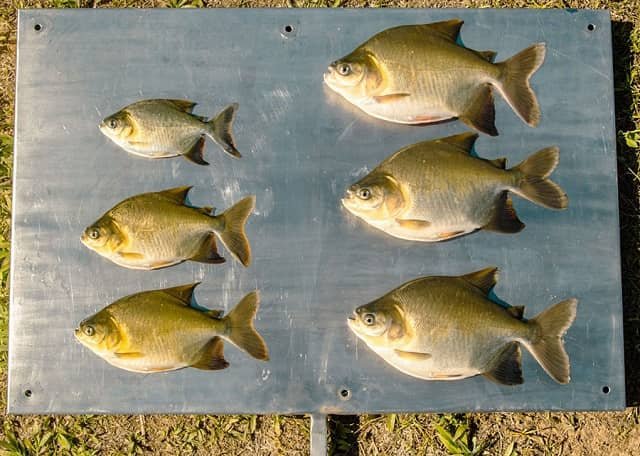
Scientists at Embrapa Fisheries and Aquaculture (TO) are studying a technique capable of making tambaqui (Colossoma macropomum) grow approximately 20% larger and heavier. Tambaqui is the second most produced fish in Brazil.
The technique involves generating, by applying pressure on fertilized eggs, fish with three sets of chromosomes (triploids) to render the fish infertile. As a result, they grow and gain weight faster than under normal conditions.
The research is part of the doctoral thesis of Aldessandro Costa do Amaral, from the Federal University of Amazonas (Ufam), under the guidance of researcher Fernanda Loureiro de Almeida O´Sullivan.
Less impact in case of fish escapes
In addition to faster growth, the sterility caused by the triploid fish production technique is an advantage for the expansion of native fish farming.
“When you have a sterile fish, it opens up the possibility of regulating its cultivation in a region where it is exotic,” the researcher points out. This is because, in the event of escape into nature, sterile animals would not pose a risk of reproducing in regions where they do not belong, such as the Prata Basin in the Pantanal. “This expands the places where the species can be cultivated, by regulating the activity,” the scientist emphasizes.
Known technology
The technology is already used abroad in fish such as salmon and trout, and the biggest challenge was to adapt it to tambaqui, the second most produced species in Brazil.
“In trout farms in Scotland, the cultivated fish must be triploid to prevent spawning. Since these species are raised in sea cages, they need to be sterilized to prevent reproduction, which would cause genetic contamination in the natural population. Therefore, all fish must be triploid,” explains the researcher, adding that the technique itself is not new; the novelty is its application to Brazilian native fish. “It’s an old technology, relatively simple, and with a great effect on aquaculture, which we are adapting to tambaqui.”
Imported equipment
The research is part of the Aquavitae project, the largest scientific consortium ever formed to study aquaculture in the Atlantic and inland continents bathed by this ocean.
Through Aquavitae, Embrapa used from 2019 to 2023, for the initial tests of this technique, pressure equipment suitable for inducing chromosomal polyploidy in fish. The Norwegian company Nofima provided the equipment for the experiments of Embrapa Fisheries and Aquaculture.
It is a large-sized device that operates automatically, simply by adjusting the desired pressure and time. The machine is unprecedented in Brazil. “The device that most closely resembles it is from the University of Santa Catarina, however, the pressure is applied manually,” says the researcher.
How triploidy technique works
O’Sullivan explains that the research sought to define three crucial parameters for inducing triploidy. First, the moment after fertilization of the egg when the pressure shock should begin. Then, it was necessary to define the intensity of the pressure to be applied to tambaqui, and finally, the team had to determine the ideal duration of the pressure. “We had to identify these three parameters for tambaqui throughout the entire project,” explains the scientist.
To perform the technique, one million newly fertilized eggs are used, which enter the pressure machine. After the pressure shock, the eggs are transferred to commonly used incubators, and the handling is the same as for traditional larviculture and fry. The amount of food is also the same per biomass; only the fish begin to grow. The researcher explains that the protocol for obtaining 100% triploids took five years to achieve after several pilot tests.
Increased growth
During the research, which evaluated the growth and fattening cycle of triploid tambaqui for six months, it was observed that the fish became 20% larger and heavier than their siblings that had not undergone the pressure shock (used as controls). The next step in the research is to assess the species’ full growth cycle, which lasts 12 months.
“We produced a new batch of triploids that we will let grow until they reach one kilogram. If the result is the same as what we obtained with the six-month-old fish, they will reach one kilogram in less than 12 months,” calculates the researcher, adding that larval survival and the appearance of deformities in these fish are also being evaluated.
Negative effects of triploidy
Another characteristic that concerns researchers is the consequences of triploidy on the immune system of these fish.
Preliminary results indicate that triploid tambaqui may have reduced resistance to challenging conditions, such as changes in water temperature. Therefore, according to the researcher, before transferring the technology to the productive sector, studies will be conducted to fully validate the technique of producing triploid tambaqui.
“The first step was to obtain a protocol that gave us 100% triploidy in tambaqui. We are very happy and hopeful to have achieved this goal. Now, other studies will assess the advantages and possible disadvantages of this technique in the production of the species,” concludes Fernanda O’Sullivan.

